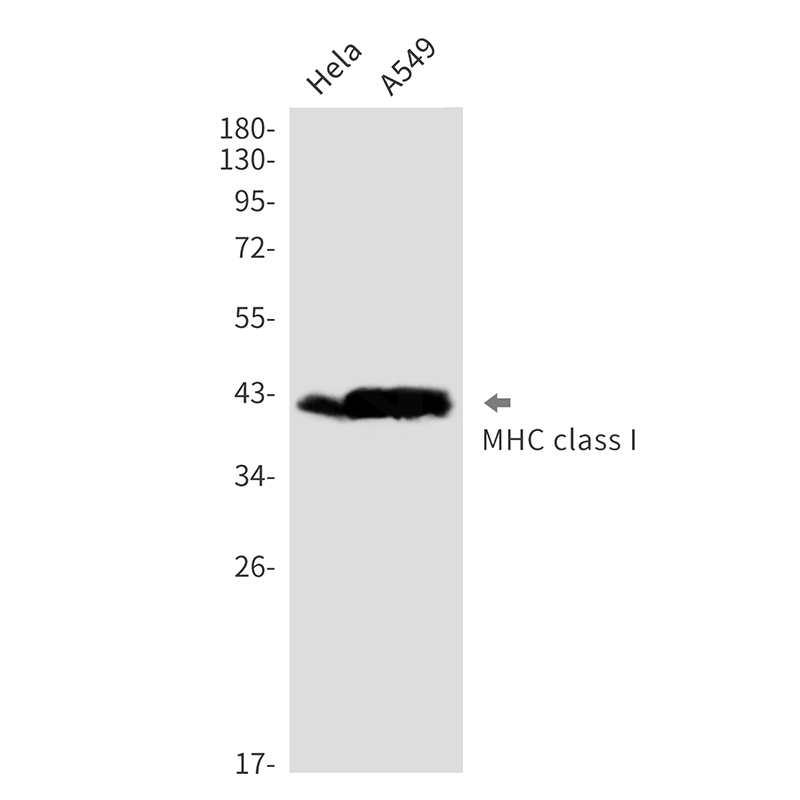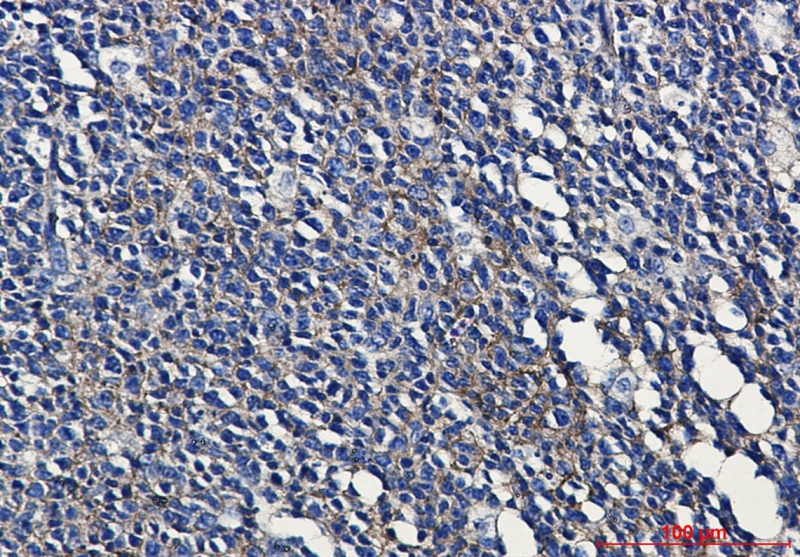

| WB | 1/500-1/1000 | Human,Mouse,Rat |
| IF | 咨询技术 | Human,Mouse,Rat |
| IHC | 1/50-1/100 | Human,Mouse,Rat |
| ICC | 技术咨询 | Human,Mouse,Rat |
| FCM | 咨询技术 | Human,Mouse,Rat |
| Elisa | 咨询技术 | Human,Mouse,Rat |
| Aliases | Aw-68; HLA class I histocompatibility antigen; A-28 alpha chain; MHC class I antigen A*68; HLA-A; MHC class I antigen HLA A heavy chain |
| Entrez GeneID | 3105 |
| WB Predicted band size | Calculated MW: 41 kDa; Observed MW: 41 kDa |
| Host/Isotype | Rabbit IgG |
| Antibody Type | Primary antibody |
| Storage | Store at 4°C short term. Aliquot and store at -20°C long term. Avoid freeze/thaw cycles. |
| Species Reactivity | Human |
| Immunogen | A synthesized peptide derived from human MHC class I |
| Formulation | Purified antibody in TBS with 0.05% sodium azide,0.05%BSA and 50% glycerol. |
+ +
以下是3-4条关于 **MHC Class I抗体** 的参考文献及摘要概括:
---
1. **文献名称**:*Structure of the human class I histocompatibility antigen, HLA-A2*
**作者**:Bjorkman, P.J. et al.
**摘要**:该研究首次解析了人类MHC Class I分子(HLA-A2)的晶体结构,揭示了其抗原结合槽的构象,为理解MHC I类分子与T细胞受体(TCR)及抗体的相互作用提供了结构基础。
---
2. **文献名称**:*Antigen processing and presentation by MHC class I molecules*
**作者**:Rock, K.L. & Goldberg, A.L.
**摘要**:综述了MHC Class I分子介导的抗原加工和呈递机制,包括蛋白酶体降解抗原、TAP转运肽段至内质网,以及抗体靶向MHC I-抗原复合物的潜在治疗应用。
---
3. **文献名称**:*MHC class I antigen cross-presentation: mechanisms and therapeutic exploitation*
**作者**:Hansen, T.H. & Brodsky, F.M.
**摘要**:探讨MHC Class I分子在交叉呈递外源抗原中的作用,并讨论了针对该途径的抗体开发策略(如增强疫苗效力或抑制自身免疫反应)。
---
4. **文献名称**:*Monoclonal antibodies to HLA antigens and their uses*
**作者**:Parham, P. et al.
**摘要**:描述了针对HLA Class I分子的单克隆抗体的开发,包括其在移植排斥监测、肿瘤免疫逃逸研究及疾病诊断中的关键应用。
---
**备注**:以上文献均为经典或高影响力研究,涵盖结构、功能及抗体应用方向。如需具体年份或期刊信息,可进一步补充。
Major histocompatibility complex (MHC) class I molecules are cell surface glycoproteins critical for adaptive immune responses. Found in nearly all nucleated vertebrate cells, they present intracellularly processed peptide antigens to CD8+ cytotoxic T lymphocytes (CTLs), enabling immune surveillance against pathogens and malignant cells. Structurally, MHC class I consists of a polymorphic α-chain (with α1. α2. and α3 domains) non-covalently bound to β2-microglobulin. The α1 and α2 domains form a peptide-binding groove that accommodates antigenic peptides typically 8–10 amino acids long.
Antibodies targeting MHC class I molecules are essential tools in immunology research and clinical diagnostics. Monoclonal antibodies (mAbs) against specific MHC class I alleles, such as HLA-A, -B, and -C in humans, are widely used for histocompatibility testing in organ transplantation to minimize graft rejection. These antibodies also aid in studying immune evasion mechanisms in cancers, where downregulation of MHC class I is common. In infectious diseases, MHC class I antibodies help elucidate viral immune evasion strategies, such as herpesvirus-mediated MHC I degradation.
Therapeutic applications include blocking antibodies in autoimmune diseases and bispecific antibodies redirecting CTLs to tumor cells. However, MHC class I allelic diversity complicates antibody specificity, requiring careful validation. Research-grade antibodies are pivotal in flow cytometry, immunohistochemistry, and functional assays to dissect antigen presentation pathways. Their role extends to vaccine development, where MHC class I-peptide complex stability influences immunogenicity. Overall, MHC class I antibodies remain indispensable for understanding immune recognition and developing targeted therapies.
×